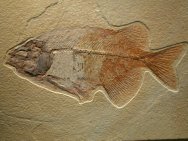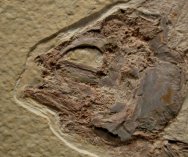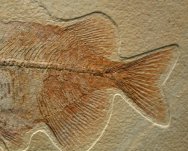|  Description:
This 50 million year old, Eocene-Era fossil fish comes from one
of the world's famous Laggerstatten, the Green River Formation in
Wyoming. A small portion of the fish fossils from Green River exhibits
such fine preservation. The significant extent of soft-tissue preservation
that makes the site famous is evident in this specimen. Description:
This 50 million year old, Eocene-Era fossil fish comes from one
of the world's famous Laggerstatten, the Green River Formation in
Wyoming. A small portion of the fish fossils from Green River exhibits
such fine preservation. The significant extent of soft-tissue preservation
that makes the site famous is evident in this specimen.
The
genus Phareodus is uncommon in the Green River formation and is
readily distinguished by the long pectoral fin (here prominantly
splayed) and large pointed teeth. There are two spcies:encaustus
and testis, of which testis is the more rare. Phareodus sports teeth
that are testiment to the fish’s carnivorous habit. In fact,
the genus name means "to have tooth". A member of family
Osteoglossidae (bony-tongues), it has extant cousins found in Central-South
America and Southeast Asia, known as the Arrowana and Arapaima.
The genus is known from the Eocene deposits of North America and
Australia.
About
the Green River Formation: Class Actinopterygii, the ray-finned
bony fishes, comprise almost half of all known species of vertebrates,
some 20,000 extant species. There are numerous locations worldwide
that are noted for wondrous preservation of bony fishes, and the
Green River formation that covers some 25,000 square miles of SW
Wyoming, west Colorado and east Utah is one of the premier examples.
The formation is one of the largest lacustrine sedimentary accumulations
in the world, and spans the period from 40 to 50 million years ago
during the Eocene Epoch.
During
the Eocene, based on the fossil record, the region was sub-tropical
to temperate. Some 60 vertebrate taxa have been described from the
formation, including crocodiles, boa constrictors, and birds, as
well as abundant invertebrates and plants. The unusually excellent
preservation of the Green River fish fossils is usually attributed
to a combination of two factors: 1) a cold period during the Eocene
that would have caused dead fish to sink faster due to a less inflated
swim bladder; and 2) the great depth of the lakes and the consequent
anoxic conditions that would have often prevented scavengers from
disturbing the carcasses.
|




